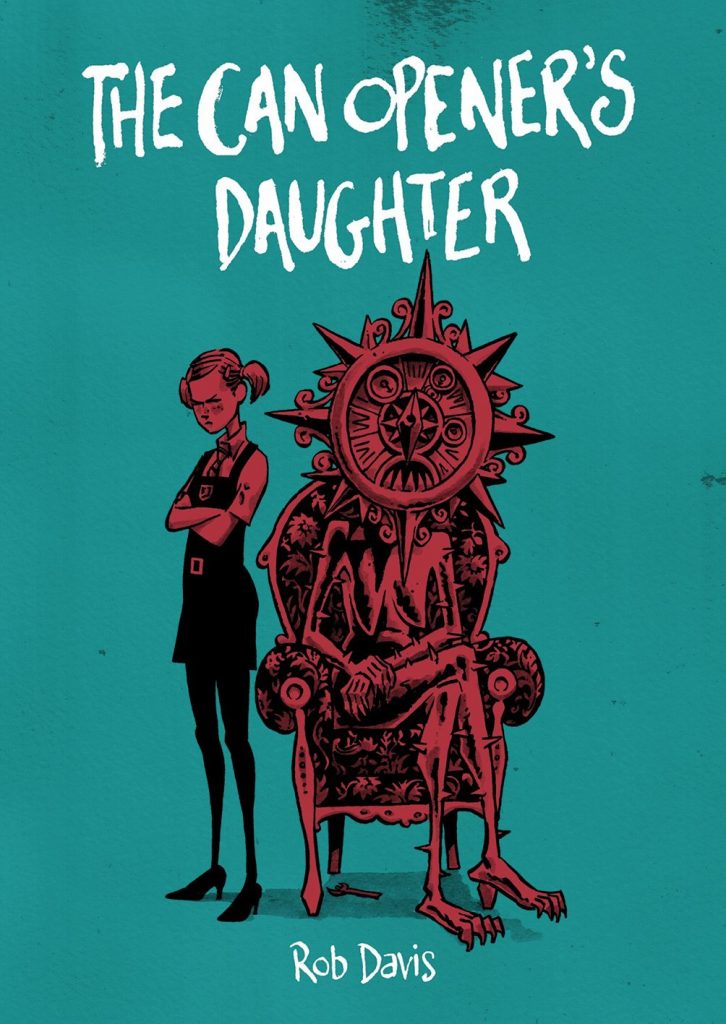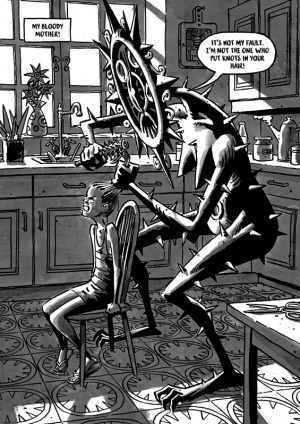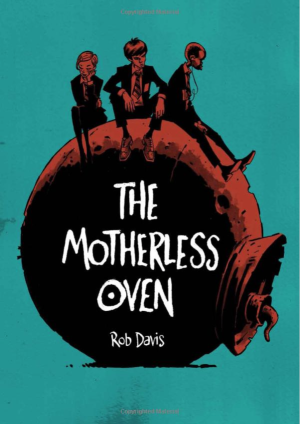Review by Graham Johnstone
Rob Davis’ The Motherless Oven ended on a cliffhanger, with no indication the story would be continued. That didn’t stop it winning a British Comic Award in 2015, and presumably selling enough copies to enable 2016’s The Can Opener’s Daughter – now billed as the second of a trilogy.
The first book opens when Vera Pike starts at a new school, and shakes up the lives of average boy Scarper Lee, and socially awkward savant Castro. It’s a modern take on the school story tradition, recuperated by J.K. Rowling with Harry Potter. Vera’s an anti-establishment thrilll-seeker, with hints of a further, hidden agenda. She quickly leads the boys out of the school and into a quest – for Scarper’s missing father, and the Motherless Oven, which they hope will answer some big questions about how the adult world works.
Davis merges genres – not just Rowling’s school story with magical fantasy, but the dystopian science fiction of Brave New World and 1984, the social satire of Jonathan Swift, and the English whimsy of Lewis Carroll and Ogden Nash – all with steampunk technology. That’s great in theory, but how is it in practice?
The first volume left a lot questions unanswered, not only about the fate of Scarper – captured as he approaches his ‘death day’, but also about the story world itself. We didn’t solve the mystery of why children make their mechanical parents, or the talking appliance ‘kitchen gods’, or the clock-like ‘daily wheels’ people watch, much less the Motherless Oven itself.
The Can Opener’s Daughter of the title is Vera, and this book drops us into her back story. Her mother is the Prime Minister of Grave Acre, and thought to be a god-like entity – the original Weather Clock. She has the ability to see and act through weather clocks everywhere. She also has a secret – having a daughter, who therefore made her, suggests she’s not the true Weather Clock – just a copy. The complex story world feels a burden at times, but the human story of young Vera railing at the constraints and wanting to enter her mother’s world, is convincing and well told. She’s subjected to intrusive brain probes to reveal more about her creation of her mother, then packed off to boarding school. Here Davis’ imagination really pays off, playing out the usual hierarchical and tribal pupil relations in an ingeniously grotesque school regime, reminiscent of the dark fantasy of Mervyn Peake. Others suffer the severest punishments, but Vera escapes intact, physically at least. This thoroughly engaging sequence, comprising the first half of the book, follows Vera right up to her arrival at the boys’ school, when the first book begins.
From there, we rejoin Vera and Castro’s quest to save Scarper before his imminent death day. They have a number of encounters that are imaginative, but hardly progress the characters or quest, and when the resolution comes, it feels unearned. The climactic encounter with the establishment figure does deliver some character insights, but these are told in dialogue more than dramatised in action.
Davis is an assured draughtsman and storyteller, his characters are distinctive and stylish, and Vera subtly matures from child to teenager. The story world is equally well realised: the intricate clocks, mysterious paintings, various devices, and particularly the Weather Clock herself (pictured) – a modernist sculpture of wrought-iron and thorns, evocative of Mike McMahon’s artful distortions.
There’s enough to love in both art and writing to carry readers through an overcomplicated story world, and some loss of narrative momentum, to look forward to the final volume, The Book of Forks.





